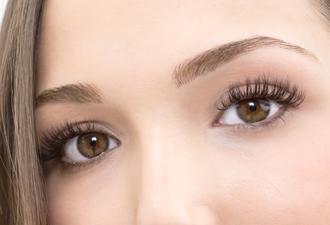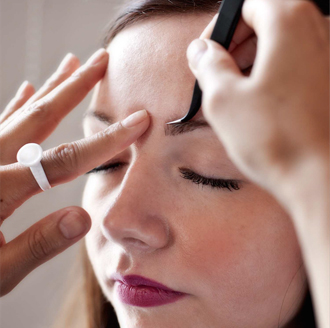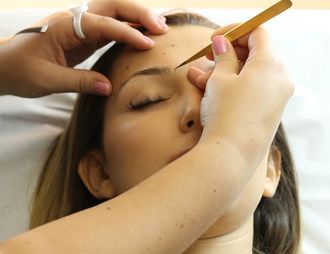Next dimension
New techniques are taking lash and brow treatments 3D. Eve Oxberry explores the extension options
The lash and brow treatment sector has seen a huge transformation in recent years, from the salon staples of tinting and threading to a creative specialism in its own right, with measuring, shaping, colouring, conditioning and extending all in the technician’s repertoire. The most recent trend to shape the market, however, is 3D – both in multi-lash extensions and real-hair eyebrow treatments.
LASHING OUT
Hear the term 3D lashes and you immediately think extreme, wide-eyed looks, but in reality 3D techniques often give a more natural finish, and can be used on clients whose lashes are not naturally strong or long enough to hold traditional extensions. “Synthetic extensions are measured by thickness but for the 3D lashes we do it by weight so some clients can take thick, long lashes, others more sparse. It’s a very personalised treatment,” says Izzy Jaffer, who trained with Ruthie Belle and has offered the 3D lashes in her Surrey salon Institut de Beauté since April. “With normal extensions I can’t always give clients what they want because their lashes are often too fine or short to take the weight.”
3D extensions involve gluing two or more hairs to one natural lash, giving a fuller effect than regular extensions. The effect is sometimes called Russian layering, and is said to have originated in Eastern Europe, becoming popular on UK shores over the last year. Unlike traditional extensions, which can be up to 0.3mm thick, 3D extensions tend to be 0.05 or 0.07mm. “It’s a more advanced technique but you can create a soft, fuller, feathery look by applying up to six very fine single lashes to the natural lash,” explains Ruth Atkins, educator at Salon System, which trains therapists in techniques including Feathering, to create soft, wispy and bespoke lash looks, and Stack and Extend, to create volume and drama. “Applying two lashes becomes 2D, applying three lashes becomes 3D, etc.”
Jaffer says another major benefit of 3D lashes is that they last more evenly. “Normally if one drops off you have a big gap, whereas with 3D you still have two or three left on the lash,” she adds. “They say 3D lash treatments last three months but you do need in-fills in that time because your natural lashes don’t last that long.”
 Lash Perfect trains therapists in two types of 3D technique – Russian layering and a new method, developed by director Beverley Piper, called Tahitian feathering (left). The latter uses multiple lengths of extension on each lash to create a softer, downier look. “Clients who want very full lashes are often those whose natural lashes are damaged or very fine,” says Lash Perfect’s expert technician Natalie Piper. “The answer is not to apply a thick extension, as this can weigh down the natural lash. Applying four 0.05mm lashes is still lighter on the natural lash than using a 0.2mm.”
Lash Perfect trains therapists in two types of 3D technique – Russian layering and a new method, developed by director Beverley Piper, called Tahitian feathering (left). The latter uses multiple lengths of extension on each lash to create a softer, downier look. “Clients who want very full lashes are often those whose natural lashes are damaged or very fine,” says Lash Perfect’s expert technician Natalie Piper. “The answer is not to apply a thick extension, as this can weigh down the natural lash. Applying four 0.05mm lashes is still lighter on the natural lash than using a 0.2mm.”
ADVANCED TECHNIQUE
Trainers agree that the technique takes a lot of practice and is only suitable for advanced technicians. “I practised on a lot of friends and learnt to personalise the technique first before I did clients,” says Jaffer. “With normal extensions you just dip the lash in glue and drop it on, whereas with the 3D lashes you have to really look at the eye and work out where to place them and which lashes can take one, and which need two or three. It’s a lot more creative.” The technique takes longer and uses more product so you should always charge more for 3D lashes than standard extensions. “For a normal set I charge £97 but for 3D it’s £150,” says Jaffer, while Jenkins advises salons to charge around £20 more for 3D. “Depending on the amount of volume you are trying to create, the treatment time can be double that of a usual lash extension treatment,” says Atkins. “This needs to be reflected in the price as it can take up to three hours and use up to 300 lashes per eye.
With most salons charging considerably more for 3D lashes, marketing the differences is key. “I converted a lot of regulars. Some wanted to stick to normal extensions because of the cost but I applied a few 3D lashes for free and once they see the difference they all convert,” says Jaffer. “When I launched the treatment I also ran a 20% discount code in a local magazine to get the numbers up.”

BROW WOW
When it comes to brows the 3D trend involves gluing individual, straight extensions directly to the hairs or skin of the brow area. It was developed in part to help women who had lost their brows completely due to alopecia or cancer treatment but has also proven a hit with those whose brows have thinned during menopause or have always been sparse.
 FaceFrame 3D Eyebrows (left) was one of the frontrunners in the technique and won the Babtac Innovation prize at this year’s Professional Beauty show following its launch last year. The treatment has since been taken on in London salon 21 Curzon Street by Paula Fitzpatrick. “When I underwent chemotherapy for breast cancer almost five years ago, I lost a breast and my hair but was surprised at how much the loss of my brows affected me,” she says. “When I first heard about Faceframe, I knew it would benefit other women in the same situation and help restore their confidence.”
FaceFrame 3D Eyebrows (left) was one of the frontrunners in the technique and won the Babtac Innovation prize at this year’s Professional Beauty show following its launch last year. The treatment has since been taken on in London salon 21 Curzon Street by Paula Fitzpatrick. “When I underwent chemotherapy for breast cancer almost five years ago, I lost a breast and my hair but was surprised at how much the loss of my brows affected me,” she says. “When I first heard about Faceframe, I knew it would benefit other women in the same situation and help restore their confidence.”
Brow brand Ilah also began training therapists in 3D extension treatments last year, and founder Tahira Wells performs them herself in Nottingham. “The treatment is most popular with older clients – 50-plus, who have thinning brows but are too scared to get semi-permanent make-up,” she says. In fact Wells developed the technique as a way to offer a complete package. “My background is in hairdressing and I think you have to be like a stylist for brows and be able to treat anyone, which you can’t with brow shaping and make-up alone.” The Eyelash Design Company also offers 3D brow training under its Brow Perfect brand. “People over the years said to us, ‘if you can do lash extensions then why not brows?’,” says director Christina Jenkins. “Beverley [Piper, Jenkins’ co-director] worked on developing them for years. We thought it’d be mostly older clients who’d book in but it’s been a wide age range because full brows are so popular now and there are a lot of people who’ve always had fine brows and just want to boost them.”
Wells advises using brow make-up that lasts 24hours for the first consultation. “If they like the look, I suggest they come back for a tint, which will last about six weeks. Then once they’re used to the brows I invite them in for extensions,” she says. “I don’t recommend applying extensions on the first appointment because it can be scary, especially if they had nothing there before. It’s about gaining trust, you have to build up the treatments slowly.”
GROWTH POTENTIAL
Like most brow and lash treatments, the profit potential is good because product cost is low – roughly 44p per treatment according to Ilah. And unlike more fiddly 3D lash extensions, brow extensions are not too time intensive. Wells says the Ilah treatment takes roughly half an hour and charges £30 for it, then £15 for follow-up infill treatments. Fitzpatrick also charges around £1 per minute at 21 Curzon Street. “It can take anywhere between 15 and 45 minutes and ladies tend to come back every two weeks to have brows removed and redone,” she says.
Jenkins says there has been a lot of hype about this sort of procedure lasting months but says that’s  unrealistic. “They don’t last as long as lash extensions because brows are more mobile,” she says. “They’ll last around two weeks, less if they are attached directly to skin rather than an existing hair.” Like lash extensions, the technique requires a lot of practice and a steady hand, but Jenkins says it’s simpler than people think. “Most people find it easier than lash extensions, partly because you’re not working so close to the eye,” she says.
unrealistic. “They don’t last as long as lash extensions because brows are more mobile,” she says. “They’ll last around two weeks, less if they are attached directly to skin rather than an existing hair.” Like lash extensions, the technique requires a lot of practice and a steady hand, but Jenkins says it’s simpler than people think. “Most people find it easier than lash extensions, partly because you’re not working so close to the eye,” she says.
Homecare is fairly straightforward – tell clients to avoid water for the first 24 hours and avoid heat treatments altogether. “If possible they should buy a 72-thread satin pillow to stop hairs being pulled out or pushed in the wrong direction if they lie on their side,” says Wells.
Be it brows or lashes, the 3D trend is here to stay and with the right advice clients can achieve impressive results. Ongoing training in these developing techniques looks set to keep experienced technicians in business.
Top tip: “To speed up the process, you can always part create your 3D lash bundles on the back of micropore tape beforehand so that they are ready to apply”
Ruth Atkins, Salon System
Top tip: “Less is more when it comes to glue. If you use too much the hairs will fall off. Also, make sure you have good lighting – ideally a mag lamp – because the hairs are very short and fine”
Tahira Wells, Ilah
Top tip: “It’s vital to observe the direction of natural brow growth. And always mark out starting points, ending points and the arch of each brow first”
Paula Fitzpatrick, 21 Curzon Street
Images, from top: Simply Be; Lash Perfect; Dorothy Perkins; FaceFrame; Brow Perfect

